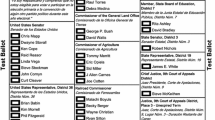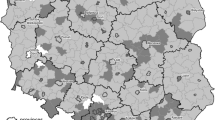Abstract
North Carolina state election law gives county election boards broad authority to determine the form of the ballot used in federal, state, and local races. This paper examines the extent to which ballot formats appear to be strategically chosen and the impact of ballot design on 1992 North Carolina elections. Our results indicate that the form of the ballot influenced the decisions of some voters in statewide races in 1992 and that the design of the ballot may have been chosen strategically by county election boards dominated by the members of one party.
Similar content being viewed by others
References
Arrington, T.S. (1978). Partisan campaigns, ballots, and voting patterns: The case of Charlotte. Urban Affairs Quarterly 14: 253–261.
Darcy, R. (1986). Position effects with party column ballots. Western Political Quarterly 39: 648–661.
Darcy, R. and Schneider, A. (1989). Confusing ballots, roll-off, and the black vote. Western Political Quarterly 42: 347–364.
Key, V.O. (1958). Politics, parties, and pressure groups. New York: Crowell.
Mather, G.B. (1986). Lost votes: Effects of methods of voting on participation Iowa 1920–1984. Iowa City: University of Iowa Institute of Public Affairs.
Matsusaka, J.G. (1993). Election closeness and voter turnout: Evidence from California ballot propositions. Public Choice 76: 313–334.
Plott, C.R. and Levine, M.E. (1978). A model of agenda influence on committee decisions. American Economic Review 68: 146–160.
Riker, W.H. (1986). The art of political manipulation. New Haven: Yale University Press.
Taebel, D.A. (1975) The effect of ballot position on electoral success. American Journal of Political Science 19: 519–526.
Thomas, N. (1968). Voting machines and voter participation in four Michigan Constitutional Revision Referenda. Western Political Quarterly 21: 409–419.
Walker, J. (1966). Ballot forms and voter fatigue: An analysis of office block and party columns ballots. Midwest Journal of Political Science 10: 448–464.
Author information
Authors and Affiliations
Additional information
We would like to thank Dale Rhoda, Justin Hoagland, and Steven J. Balla for their expert research assistance and James Loewen, Glen Newkirk, and an anonymous referee for helpful comments.
Rights and permissions
About this article
Cite this article
Hamilton, J.T., Ladd, H.F. Biased ballots? The impact of ballot structure on North Carolina elections in 1992. Public Choice 87, 259–280 (1996). https://doi.org/10.1007/BF00118648
Accepted:
Issue Date:
DOI: https://doi.org/10.1007/BF00118648




